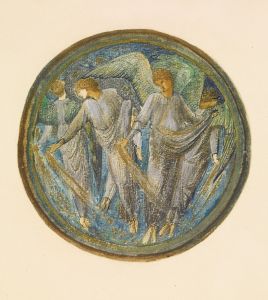
St Helena
A hand-painted replica of Sir Edward Coley Burne-Jones’s masterpiece St Helena, meticulously crafted by professional artists to capture the true essence of the original. Each piece is created with museum-quality canvas and rare mineral pigments, carefully painted by experienced artists with delicate brushstrokes and rich, layered colors to perfectly recreate the texture of the original artwork. Unlike machine-printed reproductions, this hand-painted version brings the painting to life, infused with the artist’s emotions and skill in every stroke. Whether for personal collection or home decoration, it instantly elevates the artistic atmosphere of any space.
Sir Edward Coley Burne-Jones was a prominent British artist and designer associated with the Pre-Raphaelite Brotherhood, a movement that sought to return to the detail, intense colors, and complex compositions of Quattrocento Italian art. One of his notable works is "St Helena," which reflects his interest in medieval themes and religious subjects.
"St Helena" depicts the Roman Empress Helena, who is traditionally credited with finding the True Cross, the cross upon which Jesus Christ was crucified. This subject was a popular theme in Christian art, as St. Helena's discovery was considered a pivotal moment in Christian history. Burne-Jones's portrayal of St. Helena is consistent with his style, which often features elongated figures, intricate detailing, and a dreamlike quality.
The painting showcases Burne-Jones's skill in creating a sense of narrative and emotion through his use of color and composition. St. Helena is typically depicted in a contemplative pose, reflecting her spiritual significance and the weight of her discovery. The background and surrounding elements are often rich in symbolic detail, a hallmark of Burne-Jones's work, which invites viewers to explore deeper meanings and connections within the artwork.
Burne-Jones was known for his meticulous approach to painting, often spending years on a single piece to achieve the desired effect. His works are characterized by their ethereal beauty and a sense of timelessness, qualities that are evident in "St Helena." The painting is a testament to Burne-Jones's ability to blend myth, history, and personal vision into a cohesive and compelling image.
The Pre-Raphaelite movement, with which Burne-Jones was closely associated, emphasized a return to the abundant detail, intense colors, and complex compositions of pre-Renaissance art. This movement was partly a reaction against the industrialization of the 19th century and the perceived decline in artistic standards. Burne-Jones, along with his contemporaries, sought to revive the beauty and craftsmanship of earlier periods, and "St Helena" is a reflection of these ideals.
Burne-Jones's influence extended beyond painting; he was also involved in the design of stained glass, tapestries, and other decorative arts. His collaboration with William Morris, another key figure in the Arts and Crafts Movement, further cemented his reputation as a leading artist of his time. Together, they worked on numerous projects that aimed to integrate art into everyday life, a philosophy that is evident in the detailed and harmonious composition of "St Helena."
"St Helena" remains an important work within Burne-Jones's oeuvre, exemplifying his mastery of form and his dedication to the ideals of the Pre-Raphaelite Brotherhood. The painting continues to be appreciated for its beauty and its ability to convey a sense of spiritual depth and historical resonance. Through works like "St Helena," Burne-Jones has left a lasting legacy in the world of art, influencing generations of artists and art lovers alike.


















